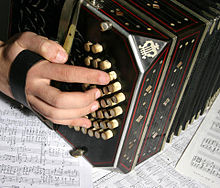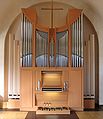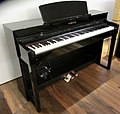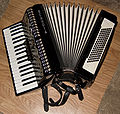Keyboard instrument
A keyboard instrument is a musical instrument in which the sound is produced indirectly by pressing down one or more keys on a keyboard. The movement of the key sets a mechanism in motion, the action, which then produces the actual sound. The instrumentalist does not have his fingers directly on the sound-producing element.
The tone production of acoustic keyboard instruments can be very different. A distinction is made between striking (piano, celesta, dulcimer), plucking (harpsichord) or blowing (organ, accordion). Keyboard instruments occupy a special position in the groups percussion instruments, plucked instruments and wind instruments. Electronic keyboard instruments can be used as master keyboards to control external or integrated synthesizers, samplers or computers via MIDI or USB interface.
In the acoustic instruments of Western and Western music white and black keys on a keyboard are common. Other arrangements are found on the button accordion or bandoneon, where buttons are operated instead of keys.
On most keyboard instruments, the notes that can be played are fixed in pitch by the keyboard; it is not possible to glide seamlessly from one note to another. Exceptions are electronic keyboard instruments.
What all keyboard instruments have in common is that the duration of the sound can be precisely controlled from the moment the key is pressed until it is released (although in the case of the piano and harpsichord, the decay of the string represents a natural limit to the duration of the sound). Depending on the design of the specific keyboard instrument, other musical parameters can be influenced by playing:
- With the piano, the volume can be influenced by means of velocity and, to a limited extent, the timbre by means of the pedals.
- In the case of the organ and harpsichord, volume and timbre can be influenced indirectly, namely through registration.
- With the harmonium, as well as with hand-pull instruments such as the accordion, the playing pressure is under the direct control of the player and is one of the essential means of expression.
Most keyboard instruments can play several notes at the same time, so they are harmony instruments.
In the 17th century the instrumental name clavier stood for any keyboard instrument.

Bandoneon

Example of a grand piano keyboard with action
Examples
Keyboard instruments occur in the following classes of instruments:
- Chordophones: ("string sounders"): e.g. piano, fortepiano, harpsichord, spinet, virginal, clavichord, string piano
- Aerophones: ("air sounders"): e.g. organ, harmonium, accordion, melodica, portative
- Idiophone: ("self-sounding"): e.g. celesta, electromechanical musical instrument
- Electrophones: e.g. digital piano, synthesizer, keyboard, Hammond organ, Mellotron
- Hybrid instruments (combinations): e.g. claviorganum
· 
Pianos: grand and upright
· 
Two-manual harpsichord
·
Spinet
· 
Clavichord
· 
Church organ
· _-_Holm_camping,_Bindal,_Norway,_2014-07-24_(photo_by_Henning_Klokkeråsen).jpg)
Harmonium
· 
Electronic home organ
· 
Digital piano
· 
Keyboard
· 
Masterkeyboard
· 
Celesta
· 
Accordion
· 
Portative
·
String Piano
Questions and Answers
Q: What is a keyboard instrument?
A: A keyboard instrument is an instrument that is played by pressing the keys of a keyboard.
Q: How are notes arranged on a keyboard?
A: On a keyboard, the notes are usually arranged with naturals (white notes) forming the main body of the keyboard, and sharps and flats (black notes) placed in cuttings into the upper half of the naturals.
Q: How does sound come from different types of keyboards?
A: The ways in which sound comes from different types of keyboards varies. For example, in pianos hammers hit strings to make sound, while in organs air is sent through pipes to create sound. In electronic organs or synthesizers, sound is made electronically and in harpsichords strings are plucked by quills or “jacks”. In clavichords, strings are hit by metal “tangents”.
Q: What was Clavier used for in Germany during 17th and 18th centuries?
A: During 17th and 18th centuries Clavier was used in Germany to mean any kind of keyboard instrument.
Q: What colors were typically used for natural and sharp/flat keys on keyboards during this time period?
A: During this time period naturals were typically black while sharps and flats were white (as seen on harpsichords).
Q: How has electronic instruments changed how people interact with keyboards today?
A: The development of electronic instruments has brought about many different types of electronic keyboard instruments such as ondes Martenot and synthesizers. Nowadays when people talk about a "keyboard" they often refer to an electronic one rather than acoustic ones like pianos or organs.
Q: Who makes some of the most successful keyboards today?
A: Yamaha makes some of the most successful keyboards today, selling over 770,000 per year.
Search within the encyclopedia

